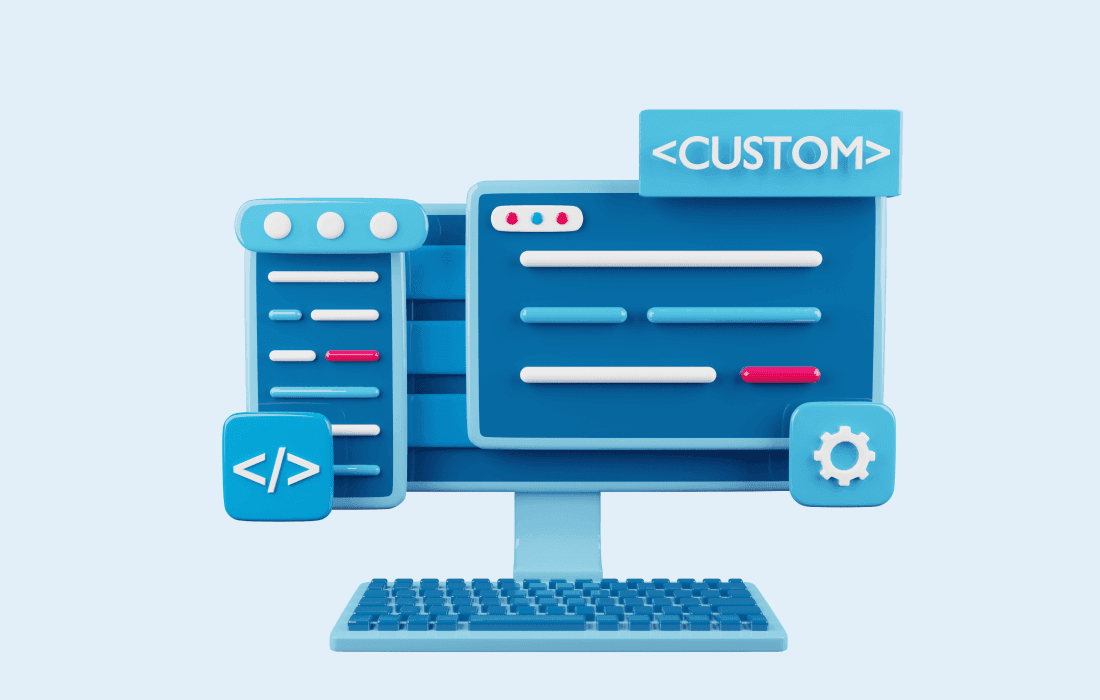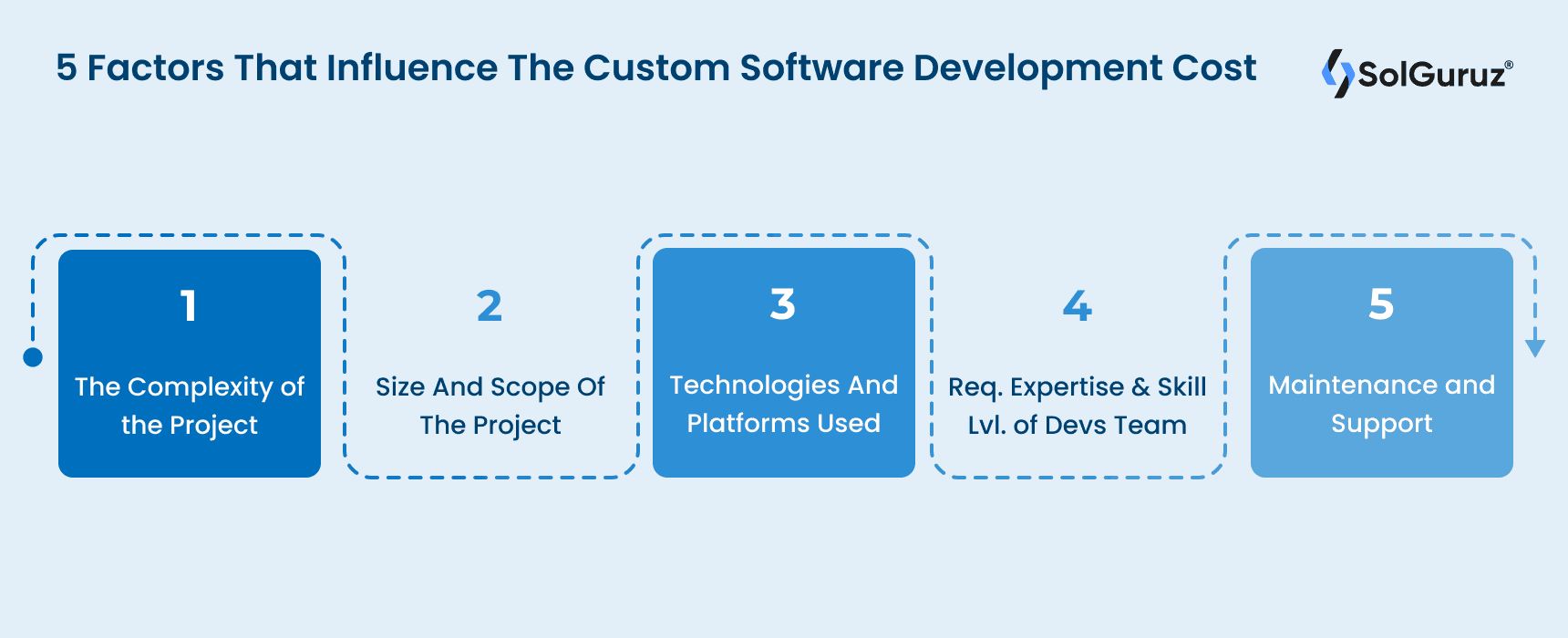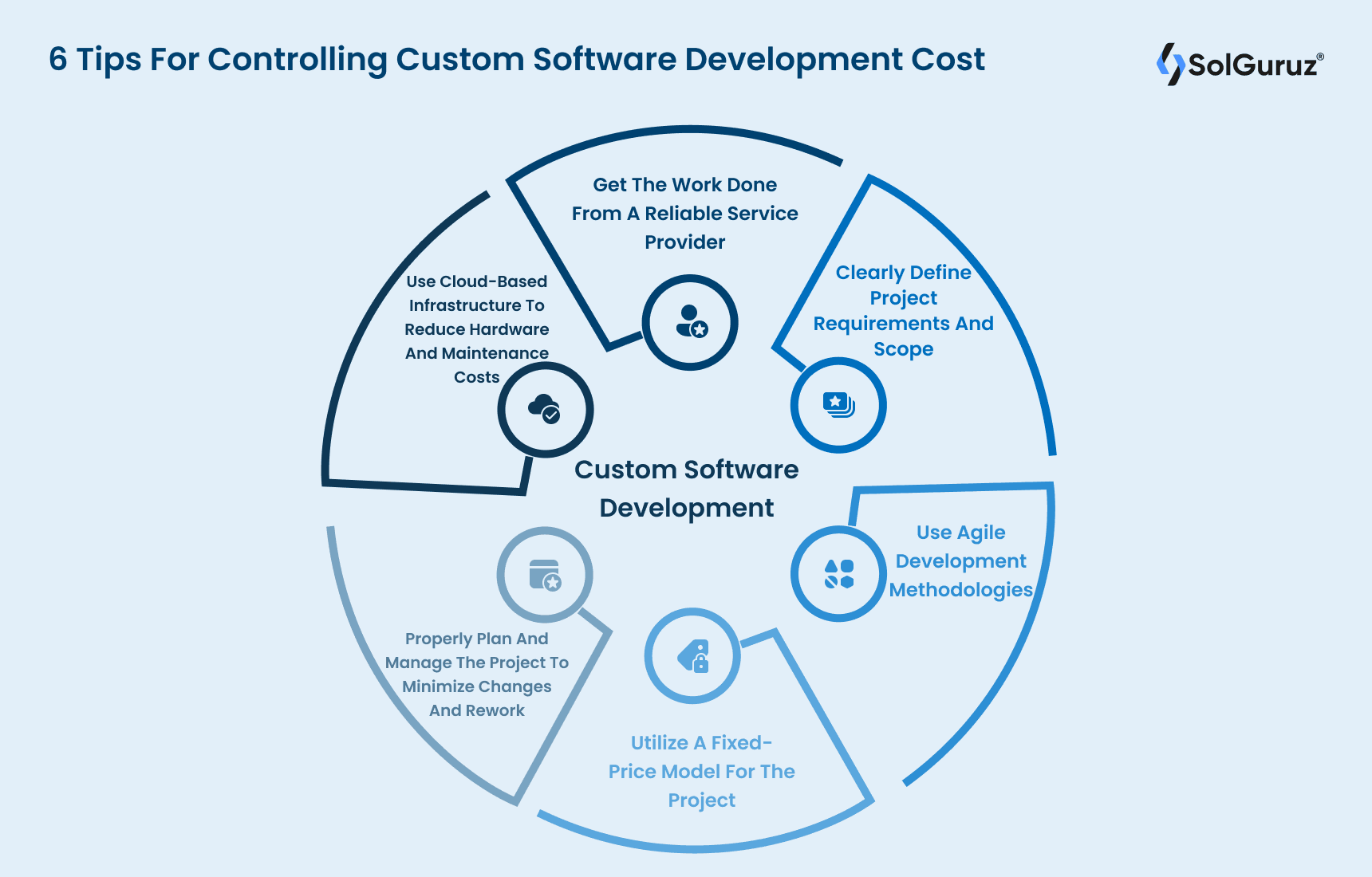Engineering Quality Solutions
Discover the key factors that impact the custom software development cost and learn how to budget for your next project.

Businesses are turning to custom software development to boost efficiency and gain a competitive edge. The global custom software development market, valued at $24.46 billion in 2021, is expected to grow at a 22.3% CAGR from 2023 to 2030. However, determining the custom software development cost can be difficult for many businesses.
Factors such as project complexity, team size, and technology used significantly affect the cost. In this blog, we dive into the factors that impact custom software development costs, giving you a clearer understanding of what you can expect to pay for your next project.
Custom software development involves creating software tailored to the unique needs and requirements of a specific business or organization. Unlike generic off-the-shelf software, custom software helps businesses improve efficiency, automate processes, and streamline workflows, providing a competitive advantage.
Here’s what custom software development can do for your business:
Businesses seeking to enhance efficiency, competitiveness, and productivity can benefit significantly from custom software development. However, it’s essential to understand the cost and other factors involved before embarking on a custom software development project.
Project size and complexity significantly impact the custom software development pricing. Here’s a short breakdown of the general cost ranges for different types of projects:

Note: These are rough estimates, and actual project costs can vary based on factors such as project complexity, development team size, and technology used.
Read ahead if you want to understand more about the factors that impact the cost of custom software development.

Project complexity is one of the most important factors influencing the cost of custom software development. The more complex are your business requirements, the more time it’ll take to develop them into a functional application or system.
Complexity may arise due to various reasons like unstructured data or extensive use of logic in programming logic etc. Also, a project that requires more complex features, functionality, and integration with other systems will typically be more expensive than a simple project.
For example, a simple website update that involves updating the design and adding a few new pages would be considered a small project and would likely be less expensive than a complex web application that consists in integrating with various systems, handling large amounts of data, and providing a unique user experience.
The size of the project refers to the number of features and functionality required, the number of users, and the amount of data the software needs to handle.
The project’s scope refers to its overall goals and objectives and how it’ll affect the organization.
Projects with larger size and scope generally cost more than smaller ones. For example, a project that involves creating a comprehensive enterprise-level software system with many features, integrations, and users will be more expensive than a simple mobile app with a limited number of features and users.
The technologies and platforms used in a custom software development or custom mobile application development project can also significantly impact costs.
Different technologies and platforms have different costs; some may be more expensive than others.
For example, developing a web application using a popular platform like Ruby on Rails or Laravel will be less expensive than producing the same application using a more specialized or advanced technology like blockchain.
Similarly, developing a mobile app using a cross-platform development tool like React Native or Flutter will be less expensive than developing the same app using native technologies like Swift or Java.
Additionally, the cost of licensing and maintenance for the technologies and platforms used in the project can add to the overall cost.
For example, if the project uses a proprietary technology or platform, the cost of licensing and maintenance can be higher than if it uses an open-source technology or platform.
To build an app that millions of people will use, you need a highly skilled team with decades of experience.
You need to hire a software development team with vast knowledge in coding languages like Java, C++ or Python, etc., as well as in database management systems like SQL Server or Oracle.
Software development skills are not easy to find and require years of training before professionals can easily use them.
The more experienced and skilled your development team is, the less time it’ll require to develop your application. This will reduce errors and ensure that your project is completed within adequate time.
The cost of hiring such developers will naturally be higher than for inexperienced ones. Therefore, this factor directly impacts how much you will pay to develop your software product.
Successful software launch doesn’t make the software successful; regular maintenance does.
Maintenance is an ongoing process that involves fixing bugs, adding features, and addressing user requests for updating the application. It’s a critical phase of custom software development and a significant contributor to the total cost of ownership (TCO).
The cost of these ongoing updates will depend on how much work it takes to keep your system running smoothly.
The maintenance cost includes updates from both internal resources and external vendors.
If you choose to outsource a launch & maintenance support company, you’ll have to pay for this service on an ongoing basis. However, you won’t have to work on anything related to maintenance, and always keep a watch.
If you do it in-house, you’ll need additional resources to handle maintenance tasks such as bug fixing and feature enhancement. Costs vary based on the number of users and locations where the application is deployed.

The first thing you should do is to get the work done by a reliable service provider who has good experience in developing custom software applications.
You may find many custom software development companies offering this service, but only hire some because they may deliver what you want or ask for more money than required. So, here’s what you should do:
When working with a company on a project, both sides must understand what they are getting out of it and their roles. If there are any problems or concerns along the way, then both parties need to communicate to resolve them quickly before things get out of hand.
To clearly define project requirements and scope, businesses should take into consideration several factors:
A clear understanding of the project’s requirements and objectives will help ensure that the project is completed on time and within budget.
You can use a discovery process (aka Discovery Phase) where both parties discuss their needs and requirements before any actual work begins.
A good discovery process will help you avoid scope creep later in the project when new features are requested after development has already started. It’ll also ensure everyone is on the same page regarding what they’re building, why they’re building it, and how much it will cost.
Agile development methods are a great way to control cost and schedule when building custom software. It has been used by many large companies, including Amazon and Google, and is now gaining popularity among small businesses.
The main principle behind agile is that you build the software in small chunks, called sprints or iterations.
In each iteration, the team defines what tasks will be completed by the end of the iteration (usually between two and six weeks). At the end of each iteration, you review how things went with your customers and stakeholders, then adjust your plans for the next iteration accordingly.
Agile development is popular with startups because it allows them to rapidly develop their products without wasting time on requirements or design work that won’t be used in the final product.
The agile approach also emphasizes testing and quality assurance during development, which can help reduce bugs once the product is released.
The best way to control costs is to use a fixed-price model for your project.
A fixed-price model means that you know your budget when beginning work on the project. Fixed-price model is advantageous than other pricing models as you can be more accurate with your estimates, and it gives you a better idea of how much time it will take to complete the project.
You will pay only when the custom software development company completes the project and delivers to your satisfaction. This eliminates any uncertainty about the final cost because there are no hidden charges or extras.
There is also less risk of changing requirements becoming an issue later in the project if you negotiate the changes before the custom software development company starts the work. (this also reduces scope creep).
There are no auditors or accountants involved in payment negotiations, so it’s easier to get everyone on board with this approach right from the start.
Before you start a project, create a detailed business case that outlines why your company needs this software, how it will be used, and by whom.
Spend time planning your project so you know exactly what you need to build and how much time it will take. This includes creating detailed specifications for each feature, writing user stories, and estimating effort based on experience with similar projects or from other developers’ estimates.
Once the project is underway, make sure you have regular status meetings so everyone is on the same page about what is being built and when it will be ready for deployment.
During development, there will likely be changes requested by users or stakeholders that may add time or money to the project – for example, if someone requests additional functionality or wants their customizations added to an application during development.
Make sure the requests are documented immediately so everyone knows what needs to be done before continuing with development work (for example, if an IT administrator is needed to implement this change).
In the past, businesses have had to pay for expensive hardware and software to run their operations. However, cloud-based infrastructure now means you can use software without buying servers or installing programs on your computer.
The cloud-based infrastructure allows you to build and run your applications on virtual servers hosted by a third party. There’s no need to worry about buying hardware or maintaining software. Instead, you pay for the amount of bandwidth and storage used by your application.
This gives small businesses access to enterprise-level technology without investing in expensive software licenses or hardware maintenance contracts. Here are some tips:
Use cloud computing services like Amazon Web Services (AWS) or Microsoft Azure as an alternative to traditional hosting providers like Rackspace or GoDaddy. These services also offer managed applications that require minimal training and maintenance from IT teams – lowering costs even further.
Consider using open-source software like Apache OpenOffice and LibreOffice instead of expensive office suites like Microsoft Office or Adobe Creative Cloud Suite (CC). Open-source options are available for free or at a low cost. They often include all the features needed for business communications – including word processing, spreadsheets, presentations, and email clients – with fewer security risks.
The time required to create custom software depends on the project’s complexity, but it is usually between 4 and 9 months.
The most important factor for the project’s duration is the time needed for design and development. Usually, it takes about 30% of the total time to design custom software and about 70% for development.
Because every project has unique needs, there is no strict rule about how long it will take to build a custom solution. However, clients are generally satisfied with our delivery times.
SolGuruz can help you with custom software development. We understand that every business has unique requirements, and we work closely with our clients to understand their needs and develop a software solution that meets those needs.
Our services include requirements gathering, design, development, testing, and maintenance of the software. We also provide ongoing support and updates to the software as needed. We have a team of experienced UI/UX designers, software developers, project managers, and quality assurance specialists who work together to deliver the software on time and within budget.
With a proven track record of delivering successful projects for our clients, you can trust us to deliver a high-quality software solution for your business.
Custom software development can be a powerful tool for businesses looking to gain a competitive advantage and increase efficiency.
However, businesses need to understand the factors that influence the cost and take steps to control them to manage their budget for bespoke software development effectively.
With careful planning and a clear understanding how much does custom software development cost, businesses can reap the long-term benefits of custom software development without breaking the bank.
Software development costs are expenses incurred while creating and maintaining software products or systems. These costs can include expenses for labor, materials, and other resources required to design, develop, test, and deploy software. Factors such as custom functionality, integration with other systems, and ongoing maintenance and support can also affect the overall cost of software development.
The most expensive cost when developing software is typically the cost of the custom software development team. This includes charges for developers, project managers, and other team members, as well as any contractors or external resources brought in to work on the project. The team’s size and experience, as well as the project’s complexity, can all affect the overall cost of the development team.
Outsourcing custom software development can have several benefits, including cost savings, access to specialized expertise, and the ability to scale a development team as needed. Outsourcing to a company or team with a lower labor cost can lead to significant cost savings while also providing access to specialized skills and experience that may not be available in-house. Additionally, outsourcing allows for flexibility in scaling the team as needed, which can be useful for projects with uncertain timelines or changing requirements.
Software development costs are typically calculated by estimating the total number of labor hours required for each phase of the project and then multiplying that by the hourly rate for each role or skill set. The project manager, software development team lead, or dedicated estimator usually calculates software development costs.
When selling the source code for an app, the pricing strategy is similar to that of selling a business. The standard formula used is revenue * 3 + assets, where 3 reflects the market’s supply and demand of similar software. This factor accounts for the app’s potential future growth and its value as an asset. Additionally, the app’s assets, such as intellectual property, technology, and brand recognition, are also considered to determine the value of the source code.
SolGuruz is considered one of India’s top custom software development companies. They provide a wide range of services, including web and mobile app development. They have a team of experienced developers skilled in various technologies and can deliver high-quality software solutions.
Written by
Paresh is a Co-Founder and CEO at SolGuruz, who has been exploring the software industry's horizon for over 15 years. With extensive experience in mobile, Web and Backend technologies, he has excelled in working closely with startups and enterprises. His expertise in understanding tech has helped businesses achieve excellence over the long run. He believes in giving back to the society, and with that he has founded a community chapter called "Google Developers Group Ahmedabad", he has organised 100+ events and have delivered 150+ tech talks across the world, he has been recognized as one of the top 10 highest reputation points holders for the Android tag on Stack Overflow. At SolGuruz, we believe in delivering a combination of technology and management. Our commitment to quality engineering is unwavering, and we never want to waste your time or ours. So when you work with us, you can rest assured that we will deliver on our promises, no matter what.
Get the ultimate guide to developing software tailored to your business needs with SolGuruz.

1 Week Risk-Free Trial

Strict NDA

Flexible Engagement Models
Give us a call now!

+1 (646) 703 7626
Discover the latest tech trends from SolGuruz - empowering businesses with innovative solutions and transformative insights!